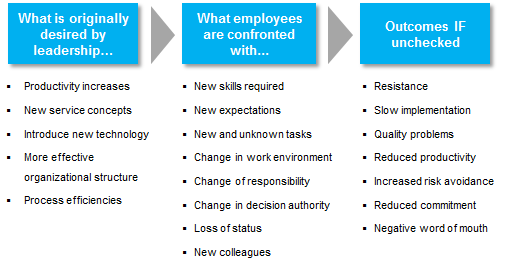Often the good intentions of leaders can morph into unintended consequences for employees when preparing to implement a large-scale business initiative (note: by large-scale we mean impacting many stakeholders). Why does this happen? In our experience, many well-intentioned leaders fail to fully appreciate the extent of the “downstream” impacts their strategic objectives will have on employees. The organizational change consultant (whether external or internal) has the important responsibility of helping leaders assess the impacts that their business initiatives will have on employees during the course of implementation.
Employees’ perceptions about what is happening is often very different from the perceptions of the leaders who launched the initiatives. If you’ve been involved in any type of large-scale strategic business initiative, you know how difficult it can be to accurately anticipate employee reactions. Whether it’s deploying a new IT system, corporate restructuring, merger integration, or process improvement effort, the realities employees are confronted with include changes to their work environment, new skill requirements, new responsibilities, and so forth.
As these changes compound, the characteristics that make us uniquely human–our emotions, pride, self-esteem, sense of independence, etc.–come to the fore and tend to complicate implementation of the business initiative. It’s the complications stemming from these human-centric characteristics that spawned the phrase: “the soft stuff is the hardest stuff” (with soft stuff of course referring to the people-related challenges). Left unchecked, these perfectly natural human reactions can result in all sorts of unintended consequences including resistance, foot-dragging, process workarounds, and risk avoidance behavior.
The illustration below, while over-simplified, represents an experience that is common to many large-scale business initiatives. It shows how the noble intentions of leaders can be perceived with much anxiety and concern by employees. If these perceptions and concerns are not addressed through solid organizational change strategy, the consequences can have significant negative impact on the program.

Savvy leaders will anticipate the employee ramifications, assess the impacts well in advance, and support the design of stakeholder engagement strategies to help manage those impacts. The responsibility of the organizational change consultant is to ensure leaders carefully consider the impacts that their program objectives will have on middle managers and front line employees, and then to manage the risk accordingly.
If you would like assistance assessing the people-related impacts of your strategic business initiative, please contact us.











3 comments
Lois Tiemann
at 1:52 am
Fantastic article, Jesse.
Jesse Jacoby
at 7:31 am
Thanks, Lois! I’m glad you enjoyed it. -J
wilson cell phone booster not working
at 7:18 am
You can also look at the number of bars that are
on your phone to test the signal strength.
Cell phone signal boosters are basically small electronic devices that capture nearby cell phone signals and
retransmit them so that they are stronger and reach into areas where signal loss may be present.
Simply, the Mobile phone signal booster renders
maximum improvement in communication for the commercial and public sectors dealing with the wide servicde and maximum use of
the phone to get in contact with the clients and employees.
Also visit my website :: wilson cell phone booster not working